

When travelling, tap water often isn’t drinkable. The best solution to avoid spending a fortune on bottled water and producing kilos of plastic waste is to treat (purify) your water. In this article, we compare the different water treatment solutions for travellers in detail: filtered water bottles, and also pressure filters, pump filters, straw filters, chemical treatments, UV purifiers…
We carried out a large survey between 17th and 20th May 2019, amongst 491 travellers who went on a long trip. We asked them many questions about how they sourced drinkable water. Learn more about our methodology
Amongst the long-term travellers:
According to the American organisation, Centers for Disease Control and Prevention, tap water is only drinkable in wealthy countries: Western Europe, North America, Japan, South Korea, Australia, New Zealand… Therefore, during your trip, you’ll rarely be able to drink tap water.
If you buy two bottles of water a day for a year, you’ll ultimately throw away around 700 plastic bottles throughout your trip. In developing countries, waste collection and recycling aren’t as well organised as our countries. So there’s a high probability that these bottles will end up in landfill sites, in nature or in the sea.
Therefore, by treating your water yourself, you’ll significantly reduce your impact on the environment.
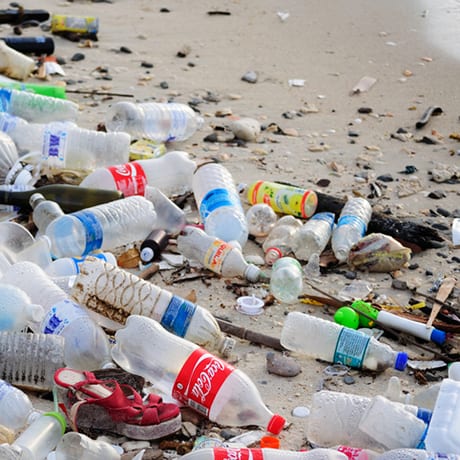

If you buy bottled water it’s likely they’ll end up here
According to Numbeo, one bottle of water costs between 40¢ and $1.10 (35p and £1) in Southeast Asia and South America. We can therefore estimate that 700 bottles of water costs around $500 for a year-long trip.
The water treatment methods that we’re going to talk about in this article only cost between $26 and $125 (£19 and £92). So you can make a real saving with them in comparison to bottled water – a saving that almost equates to the cost of your travel insurance!
Before choosing your water treatment method, you need to understand the risks associated with water for travellers.
The water in rivers, lakes and wells may be polluted by human or animal excrement or by household wastewater.
However, except when hiking, you’ll mainly drink tap water during your trip.
It’s controlled almost everywhere in the world. But, in developing countries, there’s sometimes a lack of these controls, as well as treatment and distribution systems.
If the water is contaminated, the main risk you run is catching mild or severe travellers’ diarrhoea: bouts of loose, watery poo, vomiting and stomach cramps. It may be due to the presence of dangerous microorganisms (bacteria, etc.).


In the green countries, tap water is drinkable
Bacteria are the number one cause of travellers’ diarrhoea. They don’t directly reproduce in water, but rather in particulate organic matter. They’re the easiest pathogens to kill. Bacteria are ten times bigger than viruses.
Treated by: all water treatment methods
Protozoa are often single-celled parasites that cause serious intestinal problems. When environmental conditions become unfavourable they form cysts, ceasing their movements and taking on a spherical shape. In this way, they’re more difficult to kill.
Treated by: filters with a pore size under 0.2 micrometres, UV lights. Some cysts are quite resistant to chemical treatments. So, Micropur must be left to work for at least two hours to eliminate Giardia, and Aquatabs are ineffective against Cryptosporidium.
Viruses need a living host cell to reproduce, as they don’t have their own metabolism. Due to their miniscule size, it’s extremely hard to kill them with a water filter. In cloudy water, viruses usually attach themselves to particulate organic matter. Therefore, it’s possible to get rid of them almost entirely by using a filter with a pore size under 0.015 micrometres. Nonetheless, to play it safe, it’s recommended to purify the water after having filtered it. It’s also advisable to get vaccinated against hepatitis A and against polio.
Treated by: almost entirely by a filter with a pore size under 0.015 micrometres, but just to be safe, you should use a UV light or a chemical water treatment.
Generally speaking, chemicals and heavy metals don’t cause acute problems for travellers. Adverse side effects are only to be feared in the event of prolonged exposure or after a significant accidental contamination (industrial accident, illegal discharge of polluting substances).
Treated by: carbon filters and positively charged membrane filters. They only filter the residue of chemical pollutants and heavy metals if they’re there in tiny quantities and have a very short lifespan.
Tap water is usually clear, but the water from rivers, lakes and wells can be cloudy. It may contain dissolved organic matter, clay particles and fine sand. Once the bacteria, viruses and parasites are treated, these particulates are no longer harmful, but they may make the water taste and / or smell bad.
Treated by: all filters, except for chemical treatments and UV lights (the latter are also ineffective against bacteria, protozoa and viruses in cloudy water). Activated carbon filters remove bad tastes and odours.
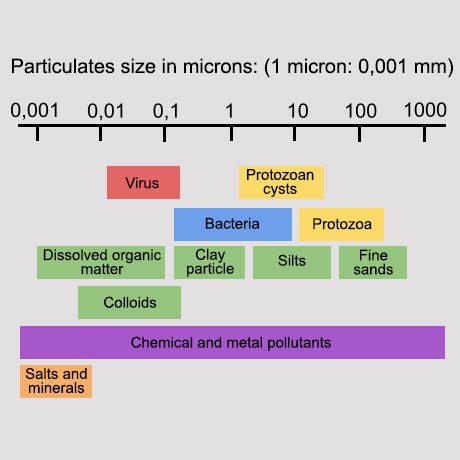

Good salts and minerals aren’t filtered by any consumer filter
Be careful, as water isn’t the only way to catch travellers’ diarrhoea. To limit the risks:
Water treatment solutions split into two main categories:
| Filtered water bottle | Pressure filter | Pump filter | Straw filter | Gravity filter | Ultraviolet treatment | Chemical treatment | Boiling water | |
|---|---|---|---|---|---|---|---|---|
  |
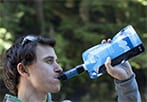  |
  |
  |
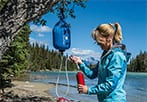  |
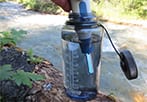  |
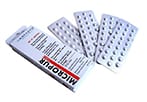  |
  |
|
| How it works | Bottle equipped with a built-in filter and sometimes a second activated carbon filter. All you have to do is sip so that the water passes through the filter. Sometimes works like a coffee press. | Like a filtered water bottle, but you have to press on a squeeze pouch to make the water go through the filter. Comes with a flexible straw so you can drink directly from the source. | Hand-operated pump with a tube on one side, to place in the water source, and an outlet on the other side, to place in a water bottle. | Tube equipped with a filter so you can suck from the water source. | Hanging water reservoir. The force of gravity pushes the water through the filter. | Device that looks like a pen that you stir in a water bottle. The UV light goes out after 45 to 90 seconds. All the water in the bottle is then treated. | Pills, drops or tablets to add to water. Often chlorine-based and sometimes also silver ions. | On a camping stove for one minute (3 minutes above 2,000 metres). |
| Percentage of RTW travellers who use this method | 40 % | 10% | 5 % | 4 % | 0 % | 5 % | 23 % | 2 % |
| Large volume of water | ||||||||
| Low maintenance | ||||||||
| Easy to use | ||||||||
| Light | ||||||||
| Cheap | ||||||||
| Fast | ||||||||
| Pros |
– Instant filtering
– Filters particulates – Some models eliminate bad tastes |
– Small and lightweight
– Instant filtering – Filters particulates – Can attach it to a water bottle / camelbak or sip directly from the source |
– Allows you to store filtered water in a bottle |
– Small and lightweight
– Instant filtering – Filters particulates |
– Stores a large amount of filtered water – No effort required |
– Small and lightweight
– Quick method – Even treats viruses |
– Weighs almost nothing
– Even treats viruses |
– Even treats viruses |
| Cons |
– Frequent leaking problems
– Takes up room in your bag – Have to sip to drink |
– Need to press on a squeeze pouch to drink | – Hand pumping gets tiresome over time | – Have to drink from the source, impractical |
– Slow process
– Sometimes difficult to find somewhere to hang it |
– Only works with clear water
– Needs to be charged from time to time |
– Slow process
– Chlorine taste – Doesn’t remove dissolved particulates – Expensive over time – Taken oven a long period of time, it can alter the intestinal flora in some people |
– Long and tiresome
– Time to cool down – Requires a stove and cooking pot – Doesn’t remove particulate organic matter |
| Main models mentionned in our survey |
LifeStraw Go
LifeStraw Go 2-Stage Water-to-go Outdoor Grayl Ultralight LifeSaver Liberty Forclaz Trek 500 |
Sawyer Mini
Katadyn BeFree |
MSR Trailshot LifeSaver Liberty | Lifestraw | Platypus Gravity Works |
SteriPen Aqua
SteriPen Classic 3 SteriPen Adventurer SteriPen Ultralight SteriPen Ultra |
Micropur Forte
Aquatabs |
– |
Choosing the right treatment method for you will depend on what you want to use it for:
The level of risk you’re willing to take will also influence your choice, especially concerning whether or not to filter viruses. During our survey, lots of respondents told us that they were very satisfied with filters that let viruses through, like the Sawyer Mini or the LifeStraw Go. Nobody told us they’d become ill when using them.
In fact, the risk of catching travellers’ diarrhoea from water mainly comes from bacteria and protozoa that are killed off by all treatment methods. However, this doesn’t mean that it’s impossible to catch a disease with a filter that lets viruses through. If you want to be almost certain not to catch anything, choose a model that also treats viruses.
Treated water can sometimes have a bad taste, even if it’s safe. If you want to get rid of this bad taste, go for a water bottle equipped with an activated carbon filter in addition to the main filter, such as the LifeStraw Go 2-Stage, the Grayl Ultralight or the LifeSaver Liberty.
As well as improving the taste of the water, the activated carbon retains much of the chlorine, pesticides and lead that may be present in the water.
However, the large downside of activated carbon is that it degrades quickly. Therefore, the capsule must be replaced regularly. For a long trip, this means having to carry a large quantity of spare capsules, which takes up space and is expensive.


Diagram of the two LifeStraw Go 2-Stage filters
Not a single consumer water treatment solution can be used to drink seawater or urine. For this, you’d need to use much heavier and more expensive professional filters.
During our survey, the main criticism of filtered water bottles is, by far, the fact that they leak. The LifeStraw Go and the Water-To-Go bottles have a huge problem with leaking.
As soon as they’re not held upright, water flows out of the spout. What’s more, even when they’re vertical, differences in pressure, like when you go up to higher altitudes or when you take the plane, push the water out of the bottle.
The water then soaks your backpack contents and risks damaging your electronic devices: camera, tablet…
To avoid this problem, which seems to apply to almost all filtered water bottles, the best option is to go for a UV light, like the SteriPen products, or a pressure filter, such as the Sawyer Mini.
Filtered water bottles and straw filters make it possible to drink any water instantly, by sucking through a straw. However, the fact of having to suck to make the water go through the filter can get a bit tiresome after several months on the road.
With pressure filters and pump filters, you won’t need to suck to drink, but you’ll still have to put a bit of effort in: pressing on a squeeze pouch or pumping.
With gravity filters, you need to find somewhere to hang the water pouch and wait for the liquid to pass through the filter. This is quite a tedious method, but particularly well-suited to groups or families who stay in the same place for a long time.
If you use a UV light, you have to stir it for 48 seconds in a 16.9 fl oz (500 ml) bottle. So it’s not instant, but pretty quick nonetheless and you don’t have to suck, which is nice in the long run.
Purification tablets take a lot longer: 30 minutes minimum for Micropur Forte and two hours to be sure to have killed off the Giardia protozoa. This really isn’t practical when travelling.
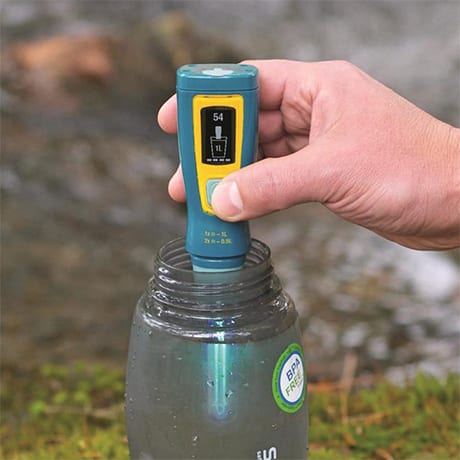

The SteriPen treats water in a bottle in 48 seconds
Filtered water bottles can store water directly, so you don’t have to look for water sources during the day.
Straw filters, on the other hand, aren’t practical at all. You have to drink directly from the source and you can’t pour filtered water into a bottle.
With the other treatment methods (UV light, pressure filter, purification tablets and pump filter), you can store the filtered water in a standard bottle that you buy separately.
When we ask long-term travellers what they’d change about their trip if they were to do it all again, many answer, “take a lighter bag”. In order to travel light, you have to carefully look at the weight of each item.
Purification tablets and straw filters are the lightest filtration systems, but very few travellers use them on a daily basis over a long period of time.
Filters equipped with a squeeze pouch, like the Sawyer Mini or the Katadyn BeFree, are lighter and take up much less space in your bag than solid filtered water bottles.
UV lights are also quite lightweight and space-saving.
Each treatment method has a lifespan and this corresponds to the number of fluid ounces / litres of water it can treat. Make sure that the lifespan of the model you choose is long enough to cover the entire duration of your trip.
During a year-long trip, allowing for 67.7 fluid ounces (2 litres) of water per day, you’ll have to treat around 23670 fluid ounces (700 litres). Therefore, we advise you to take a treatment system that has a lifespan of at least 33800 fluid ounces (1,000 litres) (or even 67600 fluid ounces (2,000 litres) if you’re travelling with another person and are using just one treatment system).
Water bottles with an activated carbon filter have two lifespans:
There’s no visual indicator to tell you when the main filter’s lifespan has expired. However, the closer to the end of its life, the harder it becomes to suck up the water. When you can no longer suck up the water, you’ll know that you need to change the filter. UV lights, on the other hand, have an LED that alerts you when your light needs to be changed.
| SteriPen Ultra | Sawyer Mini | LifeStraw Go 2-Stage | LifeStraw Go | Katadyn BeFree | Water-to-Go Outdoor | Micropur Forte | LifeStraw | Aquatabs | MSR Trailshot | Grayl Ultralight | LifeSaver Liberty | Forclaz Trek 500 | |
|---|---|---|---|---|---|---|---|---|---|---|---|---|---|
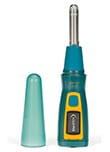
|
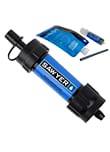
|

|
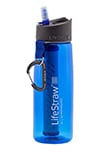
|
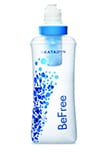
|
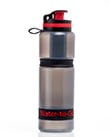
|

|

|
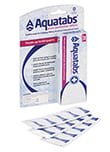
|
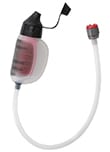
|
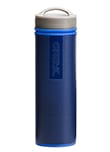
|
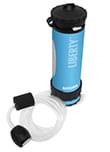
|
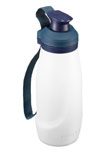
|
|
| Treatment type | UV treatment | Pressure filter with hollow fiber membrane + flexible straw | Filtered water bottle using hollow fiber membrane + activated carbon | Filtered water bottle using hollow fiber membrane | Pressure filter / flexible bottle using hollow fiber filtration system | Filtered water bottle using electrical (positive charge) filtration | Chemical treatment (chlorine dioxide and silver ions) | Solid straw using hollow fiber filtration system | Chemical treatment (sodium dichloroisocyanurate) | Hand pump using hollow fiber filtration system | Filtered one press water bottle using electroadhesion and activated carbon | Bottle + pump using hollow fiber filtration system + activated carbon | Flexible bottle with hollow fiber filtration system |
| Price |
$117 (£102) |
$44 (£38) |
$57 (£42) |
$47 (£41) |
$62 (£54) |
$38 (£33) |
$33 (£29) / pack |
$26 (£23) |
$11 (£10) / pack |
$57 (£50) |
$108 (£95) |
$125 (£110) |
$28 (£25) |
| Percentage of RTW travellers who took this system | 5% | 10% | 7% | 13% | 6% | 6% | 19% | 4% | 4% | 1% | 1% | 1% | New model |
| Percentage of RTW travellers who still bought bottles of water | 19% | 34% | 34% | 38% | 34% | 32% | 80% | 80% | 79% | Insufficient number of responses | Insufficient number of responses | Insufficient number of responses | New model |
|
Average scores in our survey
|
|||||||||||||
| Overall | 9.3 | 8.5 | 8.0 | 7.6 | 7.6 | 7.3 | 7.3 | 7.1 | 6.7 |
Insufficient number of responses
|
Insufficient number of responses
|
Insufficient number of responses
|
New model
|
| Quality of treated water | 9.4 | 9.0 | 9.4 | 9.0 | 8.9 | 9.5 | 7.9 | 8.3 | 7.7 | ||||
| Leakproofness | 9.7 | 8.8 | 6.4 | 4.6 | 7.6 | 4.3 |
Not relevant
|
9.5 |
Not relevant
|
||||
| Treatment time | 9.2 | 8.3 | 9.7 | 9.7 | 9.3 | 9.8 | 9.0 | ||||||
| Ease of set-up | 9.7 | 9.1 | 9.3 | 9.7 | 9.8 | 9.8 | 8.8 | ||||||
| Ease of filtration | 9.3 | 8.4 | 9.3 | 9.3 | 9.3 | 9.3 | 7.3 | ||||||
| Maintenance | 9.3 | 8.4 | 8.5 | 8.7 | 8.1 | 9.0 | 8.0 | ||||||
| Weight and size | 8.9 | 9.6 | 7.7 | 7.6 | 9.6 | 8.0 | 8.8 | ||||||
| Lifespan | 9.2 | 9.0 | 8.7 | 8.3 | 7.4 | 8.6 | 8.9 | ||||||
|
Filtered or treated elements
|
|||||||||||||
| Bacteria | |||||||||||||
| Cysts / parasites / protozoa |
|
||||||||||||
| Viruses | |||||||||||||
| Certain chemical pollutants and heavy metals | |||||||||||||
| Particles (sediment, microplastics) | |||||||||||||
| Removing the bad taste | |||||||||||||
|
Technical features
|
|||||||||||||
| Empty weight | 4.9 oz (140 g) | 3.5 oz (100 g) | 7.1 oz (200 g) | 6.3 oz (180 g) | 2.1 oz (59 g) | 4.9 oz (138 g) | 0.03 oz (1 g) | 1.8 oz (50 g) | 0.03 oz (1 g) | 5 oz (142 g) | 10.9 oz (309 g) | 15 oz (425 g) | 6.3 oz (180 g) |
| Dimensions |
7.1 x 2 in (18 x 5 cm) |
5.1 x 3.9 in (13 x 10 cm) |
9.1 x 3.1 in (23 x 8 cm) |
9.1 x 3.1 in (23 x 8 cm) |
9.1 x 2 in (23 x 5 cm) |
8.7 x 3.1 in (22 x 8 cm) |
– |
7.9 x 1.2 in (20 x 3 cm) |
– |
5.9 x 5.9 in (15 x 15 cm) |
9.8 x 2.8 in (25 x 7 cm) |
12.2 x 3.5 in (31 x 9 cm) |
10.6 x 3.5 in (27 x 9 cm) |
| Treatment time at start of use | 48 seconds for 16.9 fl oz (500 ml) 1.5 minutes for 33.8 fl oz (1 L) | Instant | Instant | Instant | Instant | Instant |
|
Instant | 30 minutes | 1 minute for 33.8 fl oz (1 L) | 15 seconds for 15.9 fl oz (470 ml) | 20 seconds for 13.5 fl oz (400 ml) | Instant |
| Storage capacity | Depends on the container being used | Depends on the container being used | 22 fl oz (650 ml) | 22 fl oz (650 ml) | 20.3 fl oz (600 ml) (also available in 33.8 fl oz (1L)) | 25.4 fl oz (750 ml) | None | None | Depends on the container being used | None | 15.9 fl oz (470 ml) | 13.5 fl oz (400 ml) | 33.8 fl oz (1 L) |
| Filter pore size | – | 0.1 μm (micrometre) | 0.2 μm | 0.2 μm | 0.1 μm | 0.7 μm, but can’t be compared as the technology is different | – | 0.2 μm | – | 0.2 μm | Not applicable to this technology | 0.015 μm | – |
| Lifespan: maximum number of ounces / Litres it can filter | 270,512 fl oz (8,000 L) for the lamp, 1,690 fl oz (50 L) per refill | 11834907 fl oz (350,000 L) | 135256 fl oz (4000 L) for the main filter, 3381 fl oz (100 L) for the carbon filter | 135256 fl oz (4000 L) | 33814 fl oz (1000 L) | 6762 fl oz (200 L) (20288 with a 6723 fl oz 2-pack) | 100 tablets treat up to 3381 fl oz (100 L) | 135256 fl oz (4000 L) | 80 tablets treat up to 13500 fl oz (400 L) | 67628 fl oz (2000 L) | 5072 fl oz (150 L) | 67628 fl oz (2000 L) for the main filter, 1 month for the carbon filter | 33814 fl oz (1000 L) |
| Adapter for water bottles | – | – | |||||||||||
|
Pros and cons
|
|||||||||||||
| Pros | Small and lightweight, it treats water quickly and efficiently (even viruses). You don’t need to suck to drink. | Small and lightweight, it can be attached to lots of water or soda bottles, to a camelbak or to the flexible pouch provided. It filters efficently and the filter’s lifespan is almost infinite. | Like the LifeStraw Go with an additional carbon filter that removes bad tastes from the water and filters out chlorine, pesticides and herbicides. | Instant filtration. The bottle is solid and has a carbainer so you can hang it wherever you want. The filter has a good lifespan. | Instant filtration. It’s a flexible, lightweight pouch that takes up a small amount of space. It can even be filled up in small sinks. You can also use it to fill up other bottles. | Instant filtration. The manual states that it filters viruses, heavy metals and chemical pollutants. | Tablets take up almost no space and treat water effectively (even viruses). | It’s small and Lightweight. Instant filtration. The filter has a good Lifespan. | Tablets take up almost no space and treat water effectively (even viruses). | Small and lightweight, it allows you to drink from the source or pump to store filtered water in a bottle. | The best in terms of filtration. Filtration is quick and you don’t need to suck to drink. | It’s both a bottle and a pump. It filters viruses. You don’t need to suck to drink. | Instant filtration. It takes up little space when compressed. You don’t need to suck to drink. |
| Cons | It can only be used with clear water. It needs to be charged from time to time. | Depending on the water quality, suction is sometimes a little difficult. | Like the LifeStraw Go you also need to carry several spare carbon filters, as they have a short lifespan. | The bottle leaks when it’s not held upright, as well as at altitude and on planes, because of the pressure. Therefore, it risks soaking your bag. It takes up a fair amount of room in your bag. | It’s difficult to clean and a little fragile. There may be some leaking issues after a while. | The previous model leaked. The filter’s lifespan is only 6763 fl oz (200 L), which isn’t enough for a long trip. | The treatment time is long and the treated water tastes bad. Over the duration of a long trip, it costs a lot. | It’s not very practical. You have to drink from the source or take a wide-necked bottle. You can’t store filtered water. | The treatment time is long and the treated water tastes bad. Over the duration of a long trip, it costs a lot. | You need to hand-pump to filter the water. | The bottle is heavy and takes up space in your bag. The filter’s lifespan is only 5072 fl oz (150 L), which isn’t enough for a long trip. | The bottle is heavy and takes up space in your bag. You need to take several spare carbon filters, as they have a short lifespan. | The cap on the spout opens very easily: risk of leakage. |
|
Where to buy?
|
|||||||||||||
| Buy on | Snowleader | Amazon | Amazon | Amazon | Amazon | Amazon | Amazon | Amazon | Amazon | Amazon | Amazon | Lifesaver | Decathlon |
For the sake of simplicity, we’ve only included the SteriPen Ultra (the most used amongst our RTW travellers) in our table above. SteriPen is the only portable UV light brand for travellers. However, there are five different SteriPen models which each have distinctive features.
| Steripen Aqua | Steripen Classic 3 | Steripen Adventurer | Steripen Ultralight | Steripen Ultra | |
|---|---|---|---|---|---|
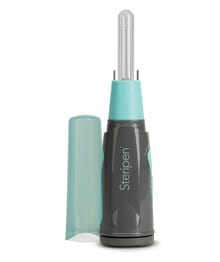  |
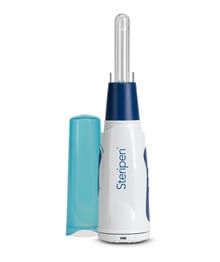  |
  |
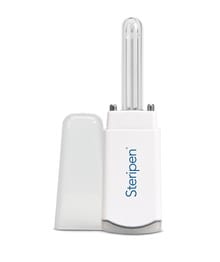  |
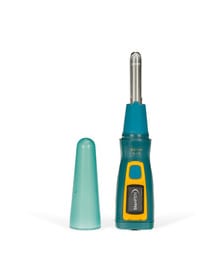  |
|
| Price | $57 (£42) | $91 (£80) | $97 (£85) | $88 (£77) | $117 (£102) |
| Weight (batteries included) | 6.3 oz (178 g) | 6.3 oz (178 g) | 3.8 oz (108 g) | 2.7 oz (76 g) | 4.9 oz (140 g) |
| Dimensions |
7.3 x 1.7 x 1.7 in (18.6 x 3.3 x 4.3 cm) |
7.3 x 1.7 x 1.7 in (18.6 x 3.3 x 4.3 cm) |
6.1 x 1.3 x 0.9 in (15.5 x 3.3 x 2.2 cm) |
5.1 x 1.4 x 0.9 in (13 x 3.5 x 2.2 cm) |
7.3 x 1.6 x 1.3 in (18.6 x 4.1 x 3.2 cm) |
| Minimum neck diameter | 0.9 in (22 mm) | 0.9 in (22 mm) | 1.4 in (35 mm) | 1.5 in (38 mm) | 0.8 in (20 mm) |
| Supply | Batteries | Batteries | Batteries | USB rechargeable battery | USB rechargeable battery |
| Volume treated per cycle |
16.9 or 33.8 fl oz (0.5 or 1 L) |
16.9 or 33.8 fl oz (0.5 or 1 L) |
16.9 or 33.8 fl oz (0.5 or 1 L) |
33.8 fl oz (1 L) |
16.9 or 33.8 fl oz (0.5 or 1 L) |
| Treatment duration per cycle | 48 or 90 seconds | 48 or 90 seconds | 48 or 90 seconds | 90 seconds | 48 or 90 seconds |
| Fluid ounces / litres per charge or per set of batteries |
1690 to 3381 fl oz (50 to 100 L) |
1690 to 3381 fl oz (50 to 100 L) |
1690 fl oz (50 L) |
676 fl oz (20 L) |
1690 fl oz (50 L) |
| UV light lifespan | 3,000 uses | 8,000 uses | 8,000 uses | 8,000 uses | 8,000 uses |
| Extras | – | Pre-filter that fits into the neck of a bottle and removes particulates from the water. | Built-in LED light | – | – |
| Price comparison |
Amazon
Snowleader |
Amazon
Snowleader |
Amazon
Snowleader |
Amazon
Snowleader |
Amazon
Snowleader |
If for some reason you don’t want to use a filtration system, the RefillMyBottle app allows you to find places where you can fill your water bottle with purified water anywhere in the world. The idea is interesting, but unfortunately the app often crashes and there aren’t yet that many places to fill up your bottle.
In our opinion, the best solution is a Steripen. It’s the system that received the best average score in our survey (9.3 / 10) and the one that prevented the most purchases of bottled water (only 19% of Steripen users bought bottled water).
It has almost only advantages:
We think that the Steripen Ultra model is the best option, as it’s equipped with a USB rechargeable battery (no need to regularly buy batteries or carry a battery charger), it treats 16.9 fl oz (500 ml) in just 48 seconds, it can treat 1690 fl oz (50 L) per refill, it can be used 8,000 times and it only weighs 4.9 oz (140 g).
If you any have doubts about the effectiveness of the Steripen, this article, published in 2015 in the scientific journal Travel Medicine and Infectious Disease, should reassure you.
The only drawback is that it can only be used with clear water. However, when travelling, 95% of the time you’ll filter tap water which is almost always clear.
If you want to be able to drink cloudy water and remove the bad taste from the water, you can combine your Steripen with a double filter (main filter + activated carbon).

